Consider this blog post your introduction to a coffee cupping and Arabian Mocha Sanani. Please join me in today’s coffee cupping at 15th Avenue Coffee and Tea. (Cupping was Saturday, December 19, 2009).
Once upon a time, Arabian Mocha Sanani was a core coffee at every Starbucks store. Then, roughly about one to two years ago, Starbucks narrowed the availability of this great coffee. Likely, the supply of the bean was too thin to send to over 6000 stores world-wide, and so the result was that this great coffee was eliminated from the North American market. Sanani returns to North America now and then as a seasonal, limited once a year offering. However, the UK and Ireland never removed Sanani from their core line up, and still to this day, our friends in England and Ireland can enjoy a great cup of Arabian Mocha Sanani by Starbucks Coffee any time they want. I am jealous.
Lucky for me, a Starbucks partner in London, knowing my passion for Sanani, has generously given me a bag to indulge in. A photo of the coffee is attached – Notice that the packaging looks a little different than the Americanized coffee packaging. Starbucks’ Sanani coffee is roasted at their Amsterdam roasting facility. I received a precious pound of this coffee from my friend in London just this past week, and then took it to 15th Avenue Coffee and Tea on Saturday the 19th for their daily cupping experience.
From the Starbucks website, we hear that Sanani is “our most exotic and unpredictable coffee, laden with flavors of deep port wine, berry fruit, warm earthen spices and cocoa.” It definitely is a rich, deep, exotic experience in a cup of coffee where wine notes and berries come together.
The coffee comes from Yemen, which rests on the Indian Ocean. Sanani refers to the coffee-growing region around Sana’a, the capital of Yemen. Starbucks recommends pairing this coffee with items like a currant scone or a slice of spicy carrot cake, if you’re doing a coffee “tasting” with this coffee.
Today, I experienced this coffee as part of a “cupping”, which is not the same thing as a regular coffee “tasting”. A cupping does not involve pairing the coffee with any food, but rather it is an exercise in experiencing the flavor of coffee on your palate and in your mouth, and discerning the sharp differences in coffees from a few different growing regions. A cupping of coffee is what roasters and those who source coffee do to determine which coffees they’ll buy, and determine the best roast level for the coffee bean. A “cupping” is an important part of continuing coffee education. A “tasting” is an experience of one or two coffees, often eaten with food, and a “cupping” is about really understanding each coffee’s unique flavor profile. In contrast, with a “tasting” there is often a discussion as to how the food paired with coffee brings out or changes the coffee’s flavors.
I arrived at 15th Avenue Coffee and immediately told a barista that I had brought a pound of Sanani to cup with the other coffees. The barista pretty quickly ripped open the package and had a good smell of the aroma of Sanani. Typically, Sanani has spicy, wine-like notes to it.
The cupping process begins with a barista weighing out 14 grams of beans. I’ve been to many many Starbucks cuppings and it is always 14 grams of beans. Sorry, but I don’t know why that is the magic number. The beans are ground through a grinder at a finer grind, close to an espresso grind. The cups of ground beans are placed on the cupping table, in order from lightest body to boldest. Just as with a wine tasting, the heaviest wine is last, so is true for a coffee cupping too.
In the next step, the barista adds water to the beans. My understanding is that the water is “hot off the boil” and that the coffee ‘brews’ for approximately 3 to 4 minutes. A crust-like layer forms at the top of the cupping cup. This is not a crema and it is not to be consumed! Next the crust is broken and the cupping participants get a good smell of the aroma of the coffees.
In the next step, customers and baristas remove the crust. This actually takes some skill to do without removing too much coffee or making a mess. Either that, or I still need remedial crust removal training.
And now finally comes the best part of a cupping: You taste the coffee. Each participant takes a cupping spoon, and scoops a small amount of coffee from the cup. Now comes the part where each person slurps loudly and either spits out the coffee, or consumes it. This is the place where there is magic. About four other customers participated in today’s cupping, and one immediately said that the Ethiopian Yirgacheffe, tasted “dessert like“. Another participant honed in on the “floral” notes of the Panama La Esmeralda Diamond Mountain coffee. Both of these two coffees are current offerings at the Starbucks Clover locations. (A Clover is a special brewer and at this time less than one percent of all Starbucks have a Clover brewer. The small number of Starbucks with a Clover also receive a supply of “small batch” coffee which are usually limited supply single-origin coffees.).
Today we cupped the following coffees:
* Unnamed 15th Avenue Coffee (a barista early in the morning had grabbed some beans from the display green bean bags and tried roasting it in the store’s toaster oven. It was most likely a bean from Guatemala).
* Starbucks Panama La Esmeralda Diamond Mountain (Currently available at all Clover Starbucks)
* Starbucks Guatemala Finca Medina
* A Kenya Gichathi-ini from another roaster
* Starbucks Ethiopia Sun Dried Yirgacheffe (Currently available at all Clover Starbucks)
* Starbucks Arabian Mocha Sanani (Currently available at Starbucks in the UK and Ireland)
Notice the coffee cupping spoons too in the pictures below; they’re nice heavy weight spoons with the Starbucks logo on them! Click on the pictures to view the full sized version (the cupping spoon will be pictured in full).
Here’s the pictorial story of today’s cupping: Enjoy! (Special thank you to Larry Aldrich of Seattle Custom Framing for his assistance with some of the photography).
[[Edit on 12-20-2009 – I’ve made a few edits for grammar. Also, just a reminder, there is a related blog entry here discussing the two mercantile Starbucks stores, and how they’re different from a regular Starbucks. There are two non-branded Starbucks – 15th Avenue Coffee and Tea, and Roy Street Coffee.]]
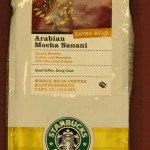
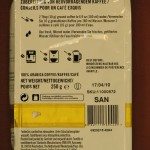
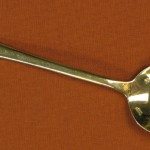
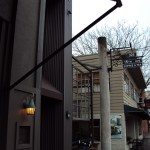
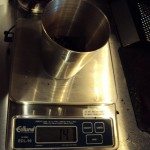
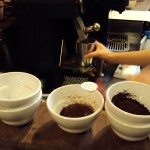

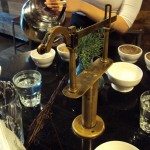
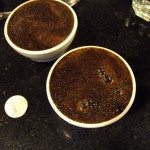
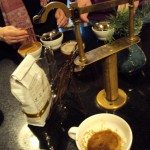
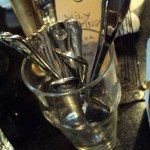
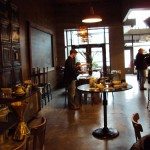
Related posts
24 Comments
Leave a Reply Cancel reply
You must be logged in to post a comment.
Sponsors
Recent Comments
- DEVIN on Compostable Straws Land in Seattle Starbucks Stores
- coffeebeanz on Why do you go to Starbucks less often? (If that’s true for you)
- Willi on You can now buy a Siren statue: $6,000
- Willi on A major revamp of your drink recipe: Testing syrup extracts and cane sugar
- Skip on Why do you go to Starbucks less often? (If that’s true for you)



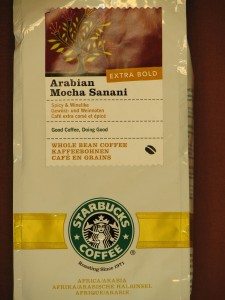



I have always loved this coffee. The wildness from cup to cup always made me go back for more. Even though we could only get a 1/2 pound of this per week it was worth it every single time.
How cool! Thank you for being so descriptive.
I wish that there were regular cuppings and/or tastings at Starbucks.
I’ll second the wish that all Starbucks did tastings/cuppings.
I really wish that anywhere around me did cuppings. I suppose that means that I should start my own coffee group.
[…] Melody Your intro to a cupping at 15th Ave Coffee: Starbucks Arabian Mocha Sanani Rocketfuel Coffee Blog An Evening Of Coffee Tasting With RocketfuelCoffee.com In two similar posts, […]
Wow~! I never realized a cupping was not a tasting and that a crust formed like that!
Would there be any reason not to try a cupping with my own beans at home?
thanks
Melody,
1st, thanks for the well-wishes for my birthday last Saturday. It was most kind of you to remember and call it out. Sorry I missed this cupping yesterday. It sounds like it was a splendid experience.
i think the cupping method is similar to how turkish coffee is made. we’ve done it at home once or twice.
When & where is it offered now in the US?
Great photos & great article! Like the others above, I will third the wish that other Starbucks would have cuppings!
I know, I need to locate my digital camera. I may just steal my husbands… my cell phone takes crappy quality pictures….
And I’m very excited about dance. It’s almost like starting brand new, since I havent in years… but I still kinda remember stuff. So I should be good. 🙂
What a great site Melody. You’ve obviously done much research and work!
isn’t 7g the ideal coffee measure? so 14g would be for 2 people to taste?
just a guess..
Christmas blend just arrived in the mail, thanks so much for having a contest on twitter, appreciate your work on the blog, cupping post opened a whole new world to me!
(@Donna and Andy) Hi Andy – I assume the 14 grams has something to do with the standardized size of the cups – There must be some kind of correct water to coffee ratio there, but I don’t know what that proportion is. By the way, my email address is sbux206@StarbucksMelody.com – Email me!
Hi Donna – Thanks for the comment! I’m glad you liked it. This post felt important to me because I’ve met many Starbucks baristas who don’t know what a cupping is!! That really is shameful and has to change. I don’t expect customers to know, but I kinda feel like I am doing my job, or meeting the goals that I set out for myself with this blog, if I can help share good new information with other coffee fans.
So… I’m at my Starbucks store right now… and I’m kinda inspired to do a cupping! Woohoo!
VERY educational!!! I should have been keeping up much better with your posts!!! This is exactly what I was wanting to learn about 🙂 THANK YOU
We had our cupping… but I think I ground it too fine. And my crust cracking skills need some help. It would also probably be helpful to have some way to keep hot water in a kettle to pour it in there. It made these huge, odd bubbles.
Cam that is great to hear you did a cupping. Crust breaking is a fine art too! Where did U get the hot water? Thank you for sharing about your cupping here!
Melody thanks for the very interesting post on cupping. Very informative. I also finally learned the difference between the non-branded stores and everything else – thank you!
I hope you have a pleasant holiday season and a Happy New Year.
Best,
James
Great post, Melody! Love the pics, too!
I always loved Sanani when it was offered as a core coffee in Canada too! I’d always brew it at home. Too bad it’s gone.
I met a barista today (‘Ryan’) who was still in the very early stages of her coffee education, but seemed really interested in knowing more. She wanted to know ‘what’s a cupping?’ because I mentioned it, and she hadn’t experienced a cupping before.
Ryan, if you do visit this site, please check out this blog entry! I realize it’s a long shot that she will see this, but she seemed to have a genuine enthusiasm to learn more about coffee…
From the pictures this seems like it is almost a french press. Normally in a french press we are supposed to mix the “crust” back into the water and let the press steep for 4 minutes. I really wish all stores were able to do this cupping method. I have never done it myself but I have seen it in pictures in Starbucks’ training materials. This looks like a great experience to have because it involves the customer more than a Barista making a french press.
To answer a couple questions: the standard ratio is 2 tablespoons of coffee to 6 oz water. About the Turkish coffee, it is a little bit different than other methods. I just saw a special on Modern Marvels about coffee and demonstrated Turkish coffee being made (as well as a little bit about the cupping that happens at Starbucks with Dub Hay). Basically a small pot has extremely finely ground coffee added with sugar. The small handled pot is brought slowly to a boil, taken off the heat for a short time then boiled again, and the process is repeated for a total of 3 times boiled. There is a good article about it on wikipedia: http://en.wikipedia.org/wiki/Turkish_coffee
Here is the segment from Modern Marvels w/ Turkish coffee I couldn’t find the whole episode anywhere:
http://www.youtube.com/watch?v=OM6wzic1M9s
Cuppings sound neat. Do they only do that up in the Seattle area? I’ve never heard about this taking place in my neck of the woods.
@Pam and @HeidiHo – More on cuppings. Cupping are the industry standard for a company that roasts coffee (and if they’re not cupping, you should worry) so it must be that there are cuppings everywhere, but they’re easy to find in Seattle.
The other local roaster with public cuppings that I couldn’t think of before is Cafe Vita. They have cuppings (so I’ve heard) on Fridays at 10 am in their main capital hill location (1005 East Pike).
You’re right Heidi that Victrola has public cuppings too: Their website says Wednesdays at 11 am, but it’s not clear to me which of their locations that is at.
And of course, Stumptown is known for their daily cuppings at 3 pm at their 12th Avenue location on Capital Hill.
15th Avenue Coffee and Tea (featured in this blog) has daily cuppings at 11 am.
I know I’ve said this before, but I genuinely think it is a great idea to go to more than one roaster’s cuppings to compare and contrast how they roast their beans. I’ve wanted to go to the Cafe Vita cuppings because I think they have a number of fine coffees, but it’s in the middle of a business day. I would assume that there are more public cuppings in Seattle than what I’ve mentioned above.